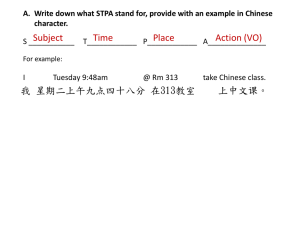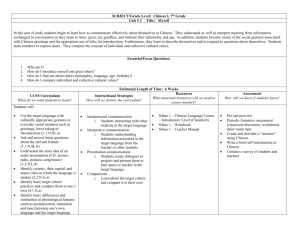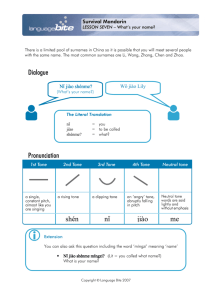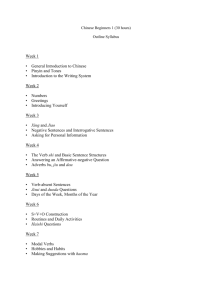Chinese characters
advertisement
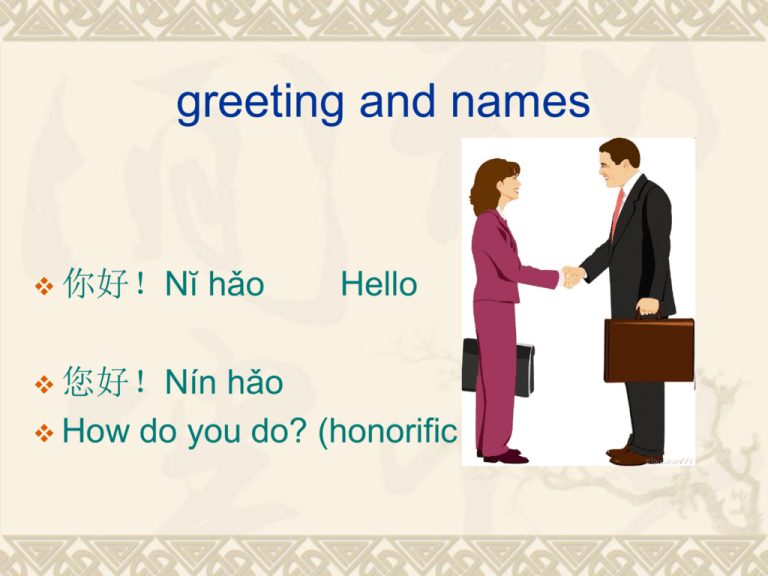
greeting and names 你好!Nĭ hǎo 您好!Nín Hello hǎo How do you do? (honorific form) words revision from lesson 1 你 nǐ 不 bú ,bù 您 nín 谢 xiè 我 wǒ 客气 kè qi 好 hǎo 再见 zài jiàn 很 hěn 吗 ma bù kè qì (bu: 4th 2nd; qi) 不用谢 bù yòng xiè (bu: 4th 2nd ;用 :need) 再见 zài jiàn 再会 zài huì (traditional; formal occasions) 不客气 revision-phrases nǐ hǎo nín hǎo nǐmen hǎo nǐ hǎo ma? wǒ hěn hǎo xiè xie bú xiè zài jiàn 你好! Hello! 您好! How do you do! 你们好! Hello to all 你好吗? How are you? 我很好。 I am very well. 谢谢! Thank you! 不谢。 You are welcome/Not at all. 再见! Goodbye! revision-Names nǐ jiào shén me ? What’s your name? 你 叫 什 么 ? wǒ jiào*** . 我 叫*** 。 My name is ***. revision-greetings 不客气。 Not at all. Bú kè qi 回头见 see you later huí tóu jiàn 晚上见 see you in the evening wăn shang jiàn 明天见 see you tomorrow míng tiān jiàn 老师 teacher lăo shī 忙 busy máng 不忙 not busy bù máng 忙不忙 are you busy? máng bù máng An interesting greeting expression 吃了吗?chī le ma 吃:verb, “to eat” 了:particle expressing perfect tense 吗:interrogative particle, as in 你好吗 Food culture, eg saying: 民以食为天 mín yǐ shí wéi tiān people regard food be heaven/God “food is the first necessity of people” zǎo shang More greetings! 早上好!good morning! zhōng wǔ 中午好!good noon xià wǔ 下午好! good afternoon! wǎn shang 晚上好! goodevening! wǎn ān 晚安! Good night! new words 生 词 tā 她 tā 姓 xìng 叫 jiào 对 duì 小 xiǎo 名字 míngzi 也 yě 什么 shénme 呢 ne 他 Ask each other’s name Question word 什么 shénme what Nĭ jiào shénme míngzi? 你叫什么名字? A: B: Wǒ jiào__. 我叫__. ne 你呢? what about you? Nĭ Ask each other’s name Tā A: Tā jiào shénme? 他/她叫什么? What’s his/her name? B: Tā jiào 他/她叫__. He/she’s called__. his/her name is __. he/she him/her Tā xìng shénme? Tā xìng ___. Cultural-Chinese names 中国人(zhōng guó rén)的名字: 姓family name+名given name 成 龙 (Chéng lóng) Jackie Chan 李 小龙 (Lǐ Xiǎolóng) Bruce Lee 张 艺谋 (Zhāng Yìmóu) 巩 俐 (Gǒng Lì) 章 子怡 (Zhāng Zǐyí) 姚 明 (Yáo Míng) Tā-his or her names Tā jiào Kǎitè ma? Duì, Tā jiào Kǎitè. Tā-his or her names Tā jiào Bèikèhànmŭ ma? Tā ne? Hālĭ bōtè 谢谢!再见! session 2 of 3 Introduction of Chinese Pinyin and tones Chinese as a language-Mandarin Spoken in People's Republic of China, Taiwan, Singapore, Malaysia Region Most of northern and southwestern China, Taiwan and Singapore (and other overseas Chinese communities) Total speakers 885 million (first language speakers) [1] Total Speakers: 1,365,053,177[1] Ranking 1 (native speakers) Chinese Language —Mandarin/ Putonghua the official Chinese language —Dialects Cantonese, Beijing speech, Shanghai speech, etc. many different dialects Chinese writing and pronunciation “Pinyin” nǐ hǎo↗ 你 好↘ “Chinese characters” Pīnyīn拼音 1.a romanised alphabetical system to indicate the pronunciation of Chinese characters. 2.used to spell Chinese names in foreign publications. 3.used as an input method to enter Chinese characters into computers. ie. 你好(hello)—nǐhǎo Chinese and Pinyin Pinyin The phonetic system used to indicate the pronunciations and tones of Chinese characters A Chinese character has one Pinyin consisting of 3 parts: an initial a final a tone Six simple finals ɑ o e i u ü as in German ü Initials b, p, m: formed through obstruction of air by upper and lower lips f: obstruction of air by upper teeth and lower lip d、t、n、l d, t, n, l: tip of tongue touching the gum of the upper teeth g、 k、 h g, k, h: back of tongue raised slightly and touching soft palate Distinguish between j, q j is similar to j as in jeep q is similar to ch as in cheese your tongue should be below your bottom front teeth when pronouncing them. For example jī (chicken), qī (seven), jiějie (elder sister) Remember to smile when you pronounce j and q! z、c、s z、c、s: tip of tongue touching the back of the upper teeth http://www.youtube.com/watch?v=U72hN_ g9pss&feature=related c: similar to ts as in cats, but it is strongly aspirated. (Have a bigger smile than z!) z: similar to ds as in birds Tones音调 Four tones 1st - high flat level 2nd / rise, from medium to high 3rd ∨ low medium→fall to the bottom→rise to high 4th ﹨ high to bottom,fall sharply neutral tone (don’t have tone mark) low flat with no stress qī 七 - seven qí 骑 - ride qǐ 起 - rise qì 气 - air qi Four tones and Neutral tone Four Tones mā má mǎ mà yī yí yǐ yì Tongue twister sì shì sì shí shì shí 四是四,十是十, shí sì shì shí sì sì shí shì sì shí 十四是十四,四十是四十, shí sì bú shì sì shí sì shí bú shì shí sì 十四不是四十,四十不是十四。 sì vs shì ; shí vs shì ; sì vs shí Glossary: 是(shì): to be am/is/are (copula) Pinyin practice – Countries Matching Task Yuēkè Yīnggélán Sūgélán Jiānádà Yìdàlì Fǎguó Scotland England Italy York Canada France Neutral Tones Māma Xièxie Jiějie Xiānsheng Tone marks on which letter? on the main vowel if more than one vowel: a→o→e: guāi, cuò, qiě if none of the above, then on ‘i’ in ‘ui’, and on ‘u’ in ‘iu’, whichever comes last Spelling rule – ǖ Initials j, q, x with ǖ drop the umlaut: ju, qu, xu No initials before ǖ add a y and drop the umlaut (the two dots): yu, yuan, yue, yun Tones practice Tone mark on which letter? 1. ba 2. Wang 3. tou 4. gui 5. xiang 6. shi Pīn yīn 拼音 Initials b p m f d t n l g k h j q x z c s zh ch sh r Chinese phonetics Single a o e i u ü ā ō ē ī ū ǖ á ó é í ú ǘ finals ǎ à ǒ ò ě è ǐ ì ǔ ù ǚ ǜ Pīn yīn -Compound finals a o e ai ei ao ou i ia u ua uo ie an üe uai uei(ui) iao iou(iu) ü en ang eng ong er i ian u uan ü üan in uen(un) ün iang uang ing ueng iong culture-Chinese Greetings zuō yī:make a bow with hands folded in front Traditional way to greet, show respect or express gratitude Outdated 作揖 Chinese Greetings jū gōng,Bowing /ˈbaʊ/, to lower the head or upper body as a social gesture In modern China, bowing is normally reserved for occasions such as wedding ceremonies and also as a gesture of respect for the deceased, although it is still sometimes used for more formal greetings, both when meeting and departing. 鞠躬 Chinese Greetings Kowtow, which is borrowed from 叩头kòu tóu in Mandarin Chinese, is the act of deep respect shown by kneeling and bowing so low as to have one's head touching the ground. An alternative Chinese term is 磕头kē tóu, however the meaning is somewhat altered: kòu has the general meaning of 'knock', whereas kē has the general meaning of "touch upon (a surface)", tóu means head. The kowtow was traditionally the highest sign of reverence in Chinese culture, but its use has been extremely rare since the collapse of Imperial China. Typical Thai greeting, which consists of a slight bow, with the palms pressed together in a prayer-like fashion. In China, not greeting, only when pray to buddha Useful Links BBC Languages- Chinese: http://www.bbc.co.uk/languages/chinese
